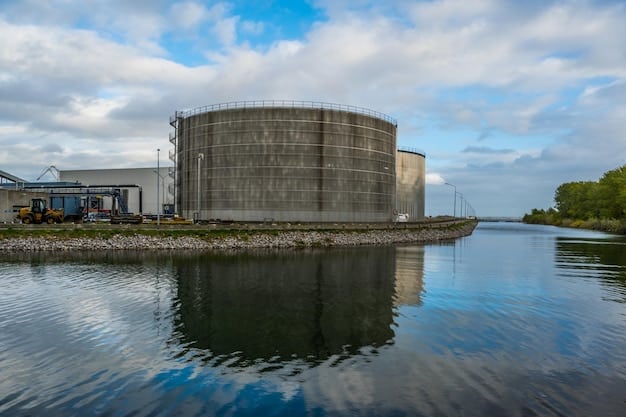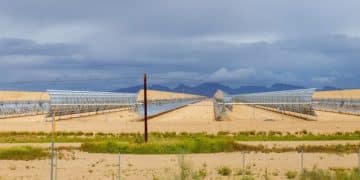The Future of Renewable Energy: Predictions for the Next Decade

The Future of Renewable Energy: Predictions for the Next Decade focuses on the growth of solar and wind power, energy storage innovations, the impact of policy changes, and the challenges of integrating renewable sources into existing grids.
The world is at a pivotal moment in its energy transition. The urgency to combat climate change, coupled with technological advancements, is rapidly reshaping the energy landscape. Let’s explore the future of renewable energy: predictions for the next decade, examining the key trends and innovations that will drive this transformation.
Renewable Energy Growth and Market Trends
The renewable energy sector has experienced remarkable growth over the past decade, and that momentum is expected to accelerate. This section will delve into the projected growth rates, market dynamics, and investment trends that will shape the future of renewable energy.
Key factors driving this growth include decreasing costs of renewable technologies, increasing government support through policies and incentives, and growing public awareness of the environmental benefits of renewable energy.
Projected Growth Rates for Solar and Wind
Solar and wind energy are expected to lead the charge in renewable energy growth. Technological advancements, economies of scale, and supportive policies are making these technologies increasingly competitive with traditional fossil fuels.
- Solar Energy: Solar capacity is predicted to increase by an average of 15% annually, driven by innovations in photovoltaic (PV) technology and the expansion of solar farms.
- Wind Energy: Wind power is projected to grow at a rate of 10% per year, with advancements in turbine technology and the development of offshore wind farms.
- Other Renewables: Hydroelectric, geothermal, and biomass energy will also contribute to the growth, though at a slower pace compared to solar and wind.
Investments in renewable energy are expected to surpass those in fossil fuels, further accelerating the transition to a cleaner energy future. This shift in investment will be crucial in supporting the development and deployment of new renewable energy projects.

Advancements in Energy Storage Technologies
One of the biggest challenges in renewable energy is its intermittency. The sun doesn’t always shine, and the wind doesn’t always blow. Advancements in energy storage technologies are crucial to overcome this challenge and ensure a reliable supply of renewable energy.
This section explores the latest developments in battery storage, pumped hydro storage, and other innovative energy storage solutions that will become increasingly important in the coming years.
Battery Storage Innovations
Battery technology is rapidly evolving, with improvements in energy density, lifespan, and cost. Lithium-ion batteries are currently the dominant technology, but other battery chemistries, such as solid-state batteries and flow batteries, are also gaining traction.
These innovations will enable greater integration of renewable energy into the grid and allow for more efficient use of stored energy. Battery storage can also provide grid stability and support the transition to a more decentralized energy system.
Other Energy Storage Solutions
In addition to batteries, other energy storage technologies are also being developed and deployed. Pumped hydro storage, which involves pumping water uphill to store energy and then releasing it to generate electricity, is a well-established technology that can provide large-scale energy storage.

Policy and Regulatory Landscape
Government policies and regulations play a critical role in shaping the future of renewable energy. Supportive policies can accelerate the transition to renewable energy, while unfavorable policies can hinder its progress.
This section examines the key policy trends and regulatory changes that are expected to impact the renewable energy sector over the next decade, including renewable portfolio standards, tax incentives, and carbon pricing mechanisms.
Renewable Portfolio Standards (RPS)
RPS mandates require utilities to generate a certain percentage of their electricity from renewable sources. These standards have been instrumental in driving the growth of renewable energy and are expected to continue to play a significant role in the future.
Many states have already adopted ambitious RPS targets, and some are considering increasing these targets even further. These higher targets will create additional demand for renewable energy and incentivize further investment in renewable energy projects.
Tax Incentives and Subsidies
Tax incentives and subsidies can help to reduce the cost of renewable energy projects and make them more competitive with fossil fuels. The federal investment tax credit (ITC) and production tax credit (PTC) have been important drivers of renewable energy growth in the United States.
These incentives are set to expire or phase down in the coming years, but there is ongoing debate about whether to extend or modify them. The future of these incentives will have a significant impact on the renewable energy sector.
Integrating Renewables into the Grid
Integrating renewable energy sources into the existing electricity grid presents significant challenges. The intermittent nature of solar and wind energy can create imbalances in the grid and require upgrades to transmission infrastructure.
This section explores the strategies and technologies being developed to address these challenges, including smart grids, demand response programs, and advanced forecasting techniques.
Smart Grid Technologies
Smart grids use advanced sensors, data analytics, and communication technologies to monitor and control the flow of electricity. These technologies can help to optimize the integration of renewable energy and improve grid stability.
- Advanced Metering Infrastructure (AMI): Smart meters provide real-time data on electricity consumption, allowing utilities to better manage demand and integrate renewable energy.
- Distribution Automation (DA): DA systems use sensors and controls to automate the operation of distribution networks, improving reliability and efficiency.
- Wide Area Monitoring Systems (WAMS): WAMS use high-speed sensors to monitor the transmission grid in real-time, enabling operators to quickly respond to disturbances.
These technologies will be essential in ensuring a reliable and resilient electricity grid as renewable energy becomes an increasingly important part of the energy mix.
Electrification of Transportation and Heating
The electrification of transportation and heating is another key trend that will drive the demand for renewable energy. Electric vehicles (EVs) and electric heat pumps are becoming increasingly popular as consumers seek to reduce their carbon footprint and save money on energy costs.
This section examines the impact of electrification on the renewable energy sector, including the potential for EVs to act as mobile energy storage devices and the role of renewable energy in powering electric heating systems.
Electric Vehicles (EVs) and Energy Storage
EVs can act as mobile energy storage devices, absorbing excess electricity during peak renewable energy production and releasing it back to the grid during periods of high demand. This vehicle-to-grid (V2G) technology has the potential to significantly improve grid stability and reduce the need for additional energy storage.
- V2G Technology: EVs can provide ancillary services to the grid, such as frequency regulation and peak shaving.
- Charging Infrastructure: A robust charging infrastructure is essential to support the widespread adoption of EVs.
- Renewable Energy Integration: Pairing EV charging with renewable energy sources can further reduce the carbon footprint of transportation.
The electrification of transportation presents both challenges and opportunities for the renewable energy sector. By working together, the transportation and energy sectors can create a more sustainable and efficient energy system.
Emerging Renewable Energy Technologies
In addition to solar, wind, and energy storage, several emerging renewable energy technologies have the potential to play a significant role in the future. These technologies include advanced geothermal systems, wave energy converters, and hydrogen production from renewable sources.
This section provides an overview of these emerging technologies and their potential to contribute to a cleaner energy future.
Advanced Geothermal Systems
Advanced geothermal systems (AGS) tap into the earth’s heat to generate electricity. Unlike traditional geothermal systems, which require access to naturally occurring hydrothermal resources, AGS can be used in a wider range of locations.
AGS have the potential to provide a reliable and baseload source of renewable energy. Further research and development are needed to reduce the cost of AGS and make them more competitive with other renewable energy technologies.
| Key Point | Brief Description |
|---|---|
| ☀️ Solar & Wind Growth | Significant expansion in solar and wind capacity due to decreasing costs and policy support. |
| 🔋 Energy Storage | Advancements in battery tech crucial for reliable renewable energy supply. |
| 📜 Policy Impact | Government policies and regulations significantly influence the growth of renewables. |
| ⚡ Grid Integration | Smart grids and demand response programs are essential for integrating renewables. |
FAQ
▼
Decreasing technology costs, supportive government policies, and increasing public awareness of environmental benefits are key drivers.
▼
Energy storage is crucial for addressing intermittency, ensuring a reliable renewable energy supply, and stabilizing the grid.
▼
Government policies, such as renewable portfolio standards and tax incentives, significantly influence the growth and adoption of renewable energy.
▼
Electrification of transportation and heating increases the demand for renewable energy, as electric vehicles and heat pumps need clean electricity.
▼
Emerging technologies include advanced geothermal systems, wave energy converters, and hydrogen production from renewable sources.
Conclusion
The future of renewable energy is bright, with significant growth expected in the coming decade. Driven by technological advancements, supportive policies, and increasing public awareness, renewable energy is poised to play a crucial role in addressing climate change. Overcoming challenges related to grid integration and energy storage will be essential to fully realize the potential of renewable energy and ensure a sustainable energy future.





